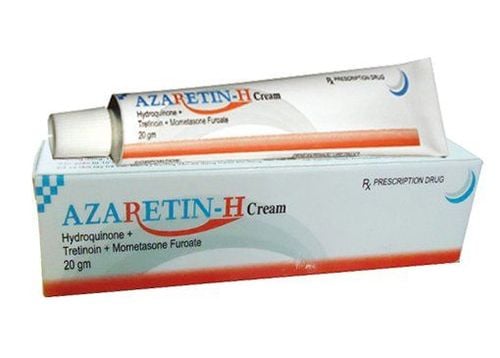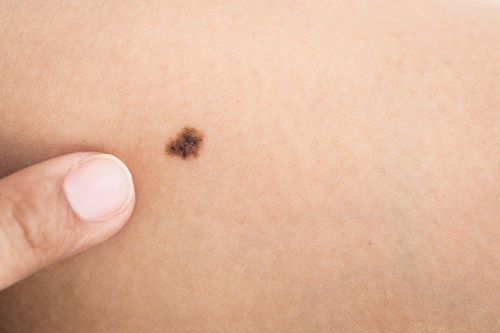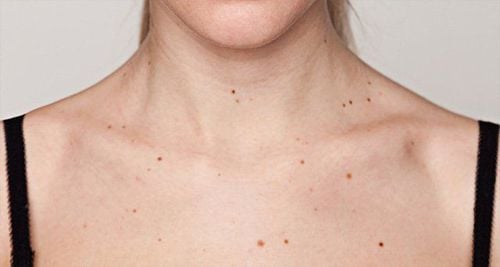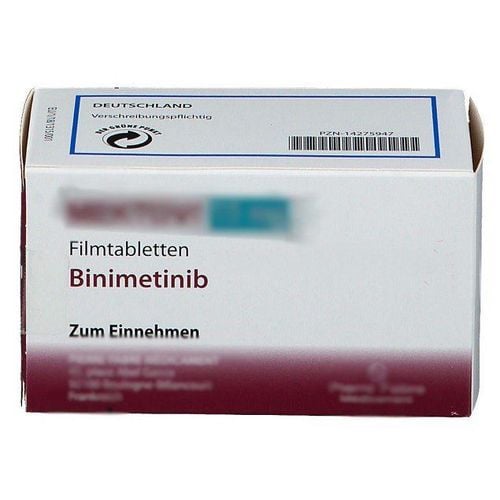This is an automatically translated article.
A mole is a benign skin lesion caused by the proliferation of pigment cells. Most of us have at least one mole on our body. They can be present from birth or into adulthood. It can be light or dark in color, can increase in size over time, these changes are normal and in some cases they turn into melanoma.
1. What is a mole?
Moles are spots on the skin. They can be flat or raised, large or small, oval or round, mottled or uniformly colored. Their color is produced by pigment cells, called melanocytes, and they can range from tan to pink, brown or black. They can appear anywhere on the skin. The exact cause of moles is unknown, but almost everyone has at least a few moles on their body.
About 1 in 100 babies are born with a mole. These are called congenital moles. Other types of moles are more likely to develop during the first 20 years of life, although we can all get moles at any age. Moles can develop over time or they can also appear suddenly.

Nốt ruồi bẩm sinh xuất hiện từ khi trẻ mới được sinh ra
2. Does the mole change over time?
Moles change over time and usually go through a life cycle of about 50 years and change gradually. Usually, they start out flat and freckle-like, then get bigger over time. They often become darker during the teen years, during pregnancy, and with sun exposure. Some moles have hair growth and some become taller and lighter in color.
3. Are moles dangerous?
Most moles are not dangerous, but nearly 50% of melanomas (a serious type of skin cancer) start in moles.
The good news is that because melanoma is rare in young children, there's no need to panic if your child has a mole. However, you should still carefully monitor these moles. Melanoma begins to appear as early as the teen years.
Some moles are more dangerous than others. Congenital moles, which are moles that were present at birth, are more susceptible to melanoma. Children should have any congenital moles checked by a doctor during a physical exam and should be referred to a dermatologist if they need further evaluation.
Another type of mole that is more likely to develop melanoma is dysplastic moles, or atypical moles. They are larger than pencil erasers and irregularly shaped. Usually they are uneven in color with lighter borders and dark brown centers. Sometimes there are black dots on the edges.

Một số nốt ruồi có thể là nguồn gốc phát sinh ung thư da nghiêm trọng
4. What should be noticed in moles?
Besides asking your doctor or dermatologist to monitor your child's moles at regular visits, you should also monitor your child's moles yourself.
The American Academy of Dermatology has several guidelines to help determine if a mole needs professional care. These are called ABCD:
A (asymmetry ) is asymmetric, i.e. if one half of the mole doesn't match the other half. B (border) is the border of the mole, i.e. if the edge of the mole is torn, notched or faded in any way C (color) is the color, if the mole is a mix of brown, black and tan rather than a transparent solid color D (diameter) is the diameter, if the mole is larger than a pencil eraser (about 6 mm or just smaller than 1/4 inch) If you notice any problems with ABCD features, make an appointment with your doctor to have a mole checked. Also, if the mole is noticeably growing or itches or bleeds, it's time to see a doctor.
5. Should moles be removed for children?
Usually we don't need to remove moles, but if your child has a mole that is bothersome because it is in an area that is frequently rubbed, talk to a dermatologist about removal options. Moles can be easily removed at a doctor's office.

Cha mẹ có thể tẩy bỏ nếu nốt ruồi khiến trẻ cảm thấy khó chịu
6. How to stop moles from growing
Moles develop mainly due to genes, but sun exposure can increase the number of moles and darken existing ones, especially in people with light skin color. Therefore, you should keep your child out of the sun during the peak hours of the day
When going outside, make sure your child wears sunscreen. Choose parks and playgrounds with plenty of shade, and ask children to wear wide-brimmed hats and long-sleeve shirts and pants whenever necessary.
Please dial HOTLINE for more information or register for an appointment HERE. Download MyVinmec app to make appointments faster and to manage your bookings easily.
Reference source: babycenter.com













